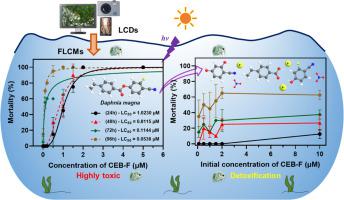当前位置:
X-MOL 学术
›
Water Res.
›
论文详情
Our official English website, www.x-mol.net, welcomes your
feedback! (Note: you will need to create a separate account there.)
Aquatic photolysis of high-risk fluorinated liquid crystal monomers: Kinetics, toxicity evaluation, and mechanisms
Water Research ( IF 11.4 ) Pub Date : 2024-03-23 , DOI: 10.1016/j.watres.2024.121510 Jingyi Wu 1 , Weibiao Ye 1 , Yiping Feng 1 , Wenhao Lao 1 , Junchun Li 2 , Haijian Lu 2 , Guoguang Liu 1 , Guanyong Su 3 , Yirong Deng 4
Water Research ( IF 11.4 ) Pub Date : 2024-03-23 , DOI: 10.1016/j.watres.2024.121510 Jingyi Wu 1 , Weibiao Ye 1 , Yiping Feng 1 , Wenhao Lao 1 , Junchun Li 2 , Haijian Lu 2 , Guoguang Liu 1 , Guanyong Su 3 , Yirong Deng 4
Affiliation

|
Despite the frequent detection of fluorinated liquid-crystal monomers (FLCMs) in the environment, the level of understanding of their fate, toxicity, and transformation remains insufficient. Herein, we investigated the degradation kinetics and mechanism of an FLCM (4-cyano-3-fluorophenyl 4-ethylbenzoate, CEB-F) under ultraviolet (UV) photolysis in aquatic environment. Our findings demonstrated that the UV photolysis of CEB-F followed first-order kinetics. Photodegradation products were identified using liquid chromatography with mass spectrometry, and detailed reaction pathways were proposed. It is postulated that through the attack of reactive oxygen species, hydroxylation, and CDaphnia magna (D. magna ) revealed significant acute toxicity of CEB-F, with LC50 values ranging from 1.023 to 0.0536 μM over 24 to 96 h, emphasizing the potential high risk of FLCMs in aquatic ecosystems if inadvertently discharged. Interestingly, we found that the toxicity of CEB-F photolysis reaction solutions was effectively reduced. Through catalase and acetylcholinesterase activities analysis along with molecular docking simulation, we proposed differences in the underlying toxicity mechanisms of CEB-F and its photolysis products to D. magna . These findings highlight the potential harmful effects of FLCMs on aquatic ecosystems and enrich our understanding of the photolysis behavior of FLCMs.
中文翻译:

高风险氟化液晶单体的水生光解动力学、毒性评价和机制
尽管在环境中经常检测到含氟液晶单体 (FLCM),但对其命运、毒性和转化的理解水平仍然不足。在此,我们研究了 FLCM (4-氰基-3-氟苯基 4-乙基苯甲酸酯,CEB-F) 在紫外线 (UV) 光解下在水生环境中的降解动力学和机制。我们的研究结果表明,CEB-F 的紫外光解遵循一级动力学。使用液相色谱-质谱鉴定光降解产物,并提出详细的反应途径。据推测,CEB-F 通过活性氧、羟基化和 CO/C-F 键裂解的攻击,逐渐降解成小分子化合物,释放出氟离子。用大型溞 (D. magna) 的急性固定试验显示 CEB-F 具有显着的急性毒性,LC50 值在 24 至 96 小时内为 1.023 至 0.0536 μM,强调如果不小心排放,水生生态系统中 FLCM 的潜在高风险。有趣的是,我们发现 CEB-F 光解反应液的毒性被有效降低。通过过氧化氢酶和乙酰胆碱酯酶活性分析以及分子对接模拟,我们提出了 CEB-F 及其光解产物对 D. magna 的潜在毒性机制的差异。这些发现突出了 FLCMs 对水生生态系统的潜在有害影响,并丰富了我们对 FLCMs 光解行为的理解。
更新日期:2024-03-23
中文翻译:

高风险氟化液晶单体的水生光解动力学、毒性评价和机制
尽管在环境中经常检测到含氟液晶单体 (FLCM),但对其命运、毒性和转化的理解水平仍然不足。在此,我们研究了 FLCM (4-氰基-3-氟苯基 4-乙基苯甲酸酯,CEB-F) 在紫外线 (UV) 光解下在水生环境中的降解动力学和机制。我们的研究结果表明,CEB-F 的紫外光解遵循一级动力学。使用液相色谱-质谱鉴定光降解产物,并提出详细的反应途径。据推测,CEB-F 通过活性氧、羟基化和 CO/C-F 键裂解的攻击,逐渐降解成小分子化合物,释放出氟离子。用大型溞 (D. magna) 的急性固定试验显示 CEB-F 具有显着的急性毒性,LC50 值在 24 至 96 小时内为 1.023 至 0.0536 μM,强调如果不小心排放,水生生态系统中 FLCM 的潜在高风险。有趣的是,我们发现 CEB-F 光解反应液的毒性被有效降低。通过过氧化氢酶和乙酰胆碱酯酶活性分析以及分子对接模拟,我们提出了 CEB-F 及其光解产物对 D. magna 的潜在毒性机制的差异。这些发现突出了 FLCMs 对水生生态系统的潜在有害影响,并丰富了我们对 FLCMs 光解行为的理解。






























 京公网安备 11010802027423号
京公网安备 11010802027423号